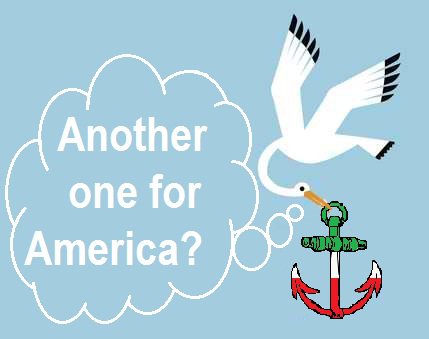
When And How Did The Anchor-Brat Legal Travesty Arise?
08/26/2015
I don’t know the answer to the question in my title above. Perhaps someone reading this can weigh in with pertinent facts.
It’s my version of a commenter’s question to Chapman University constitutional-law professor John Eastman at an article by Eastman, We Can Apply the 14th Amendment While Also Reforming Birthright Citizenship [print version here], on August 24, 2015 at National Review Online.
(Eastman clerked for Judge Michael Lustig at the Fourth Circuit U.S. Appeals Court and for Justice Clarence Thomas at the U.S. Supreme Court, and he is founding director of the Claremont Institute’s Center for Constitutional Jurisprudence. He is an expert on the history, meaning, and application of the 14th Amendment to the U.S. Constitution — notably including the question of birthright citizenship for the whelps born here to illegal aliens — and frequently writes or testifies on the subject.)
A commenter, "Stanley1," seeing that Eastman had responded to several prior comments, served up the question:
Dear Prof. Eastman,Since you're present here, perhaps you'd answer this question: When did the anchor-baby abuse actually start? With Brennan’s dictum in Plyler v. Doe?
[PN note: A "dictum" in a legal ruling is a side-remark that isn’t essential for the ruling. See the end of this entry for a reminder about Plyler v. Doe and an explanation of "Brennan’s dictum."]
Eastman replied with his own comment:
Hard to say. Mere birth was not deemed sufficient for a long time after Wong Kim Ark was decided, or else we wouldn’t have needed to have Congress offering citizenship to Native Americans in the 1923 law.We also undoubtedly would have had lots of claims about "repatriating" American citizen children when the guest worker program of the 1920s ended rather ignominiously with the Great Depression. Some [presumably "Same" — PN] problem with the Braceros program in the 1950s and 1960s. Undoubtedly there were kids born on U.S. soil to parents who were participating in that program, and to my knowledge, no one claimed they were citizens when the program ended and the parents returned home (with those kids).
So I open up the inquiry to this group of what appears to be generally well-informed commenters: Just when did the notion that birth alone was all that was necessary creep into our national understanding? Was it a policy directive issued by the Passport office or the Social Security Administration in the 1960s? Was it just Justice Brennan’s footnote in Plyler v. Doe? Or something else? Seems to me that it would be very interesting to track that down.
[Paragraph breaks added for readability. — PN]
Then two other commenters responded — in what sequence isn’t clear — to Eastman’s challenge. "Tiff" wrote:
"Just when did the notion that birth alone was all that was necessary creep into our national understanding?"Perhaps this was just the result of enforcement? If all it took was a birth certificate to gain a passport or any other citizen derived benefit, then everyone started to simply assume birthright citizenship was the law of the land. Correct me if I am wrong, but it wasn’t until the 1940s that a birth certificate was even required for proof of citizenship, much less any other documentation or proof. During that time, the poor, as well as many immigrants, never acquired birth certificates. With the advent of increased hospital births, it could have been the systematic issuing of birth certificates to every child born on US soil coupled with maintaining only the birth certificate requirement as proof of citizenship.
And "John Bowman" wrote:
I was only around 10 years old at the time, but I recall around 1965 everyone was talking about how kids born to illegal aliens were citizens and thus eligible for the new "Great Society" benefits. I think it was just a type of bureaucratic "mission creep" to use a military analogy.
Any VDARE.com readers who can offer knowledge on this point should email letters editor James Fulford. (Say whether you want anonymity.)
Regarding Plyler v. Doe, that’s the [in]famous case wherein the Supremes, with a five-justices majority behaving like legislators, forced Texas — and, by so-far-uncontested extension, other states — to provide "free" K-12 public education to illegal-alien children, i.e. children who were born elsewhere and who are illegally present in the U.S.. So Plyler v. Doe wasn’t, itself, about anchor babies.
Justice William Brennan wrote the majority’s opinion and delivered it on June 15, 1982. It’s his Footnote 10 that contains the dictum relevant to what we nowadays call "anchor babies," specifically:
[N]o plausible distinction with respect to Fourteenth Amendment "jurisdiction" can be drawn between resident aliens whose entry into the United States was lawful, and resident aliens whose entry was unlawful.
But in his recent National Review Online article, Professor Eastman wrote, "The holding of the case, as opposed to its broader dicta, does not mandate citizenship for children born to those who are unlawfully present in the United States, … " [Emphasis in original]
At this writing, about 46 hours after its posting, the Eastman article has attracted more than 500 comments, suggesting high interest in this subject.
